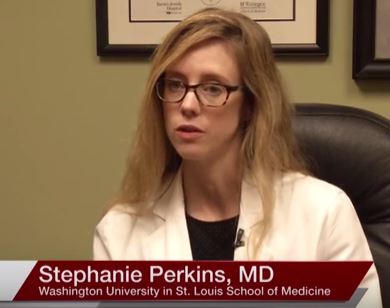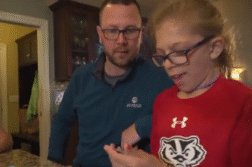Stephanie Perkins, M.D., a radiation oncologist at Washington University in St. Louis School of Medicine, talks about a new therapy that targets cancer cells.
Interview conducted by Ivanhoe Broadcast News in June 2016.
I wanted to ask you about Bridgette’s case, can you describe what she has, where the tumor is?
Dr. Perkins: Bridgette has the diagnosis of rhabdomyosarcoma and this is a tumor that we see in children. It originated near the liver and near the diaphragm. It was very large at diagnosis and she responded beautifully to chemotherapy and then underwent a surgical resection of her tumor. But there’s still indication to give radiation to that site to decrease the risk of relapse. Then she came to me to discuss radiation to that area around the liver, around the diaphragm.
What is the trick for treatment when you have a tumor that is in that area?
Dr. Perkins: This is a hard tumor because number one Bridgette is very young so she still has a lot of growing left to do. It’s a challenge because the tumor is right next to her heart and it’s also a challenge because this area moves as we breathe. All of those had to be taken you know in to consideration for her plan. How do we treat this tumor while avoiding the heart and also setting it up every day accurately while she’s breathing.
In the past for radiation what would her options have been?
Dr. Perkins: They would have typically treated her with our traditional x-ray machines which do give us some ability to image each day but have less ability to track the breathing motion that’s really what’s tricky for her. Most of the imaging that we would do on those machines would involve more radiation, either CT scan or an x-ray. That’s just more exposure for this child of radiation during her treatment.
How long is her treatment?
Dr. Perkins: Once we get her set up, she does require sedation because she’s so young so she requires that anesthesia each day. But the treatment once it gets started takes about eight minutes.
Can you describe for me what this machine will do to protect the rest of her structures?
Dr. Perkins: The machine is unique and it does come at the patient from multiple angles like most radiation machines but it utilizes and MRI to image her each day. Not only does she get a MRI when she’s set up but we also track her breathing with that scan as we’re treating and that allows us to make some adjustments for treating the tumor. If she takes in a deep breath and the tumor goes outside of the radiation field the machine stops until the tumor returns back in to the target and that’s really the unique feature for her.
What’s the health concern if she were to get radiation outside of that zone, this is very close to her heart.
Dr. Perkins: She’s had a lot of chemotherapy for this diagnosis and that has long-term effects on the heart. Obviously adding radiation to that is not good so we want to really decrease the amount of dose to the heart. That should lower her risk of heart disease or heart failure as she gets older. We need to curve that dose around the heart but we also want to decrease the margin around the tumor and the MRI helps with that because we know where it is at all times as she’s breathing.
What is her prognosis, is there any cancer visible now?
Dr. Perkins: She’s had a beautiful response to chemotherapy; her last imaging really showed no evidence of cancer. Our hope is that we decrease the risk that she has any relapse in her surgical site. Overall we feel her prognosis is really good.
Is there anything I didn’t ask you that you want people to know, I know this is being used on the pediatric patients is this also available for adults?
Dr. Perkins: This machine we’ve had now for a couple of years and it, in addition to those capabilities we talked about, being able to image the patient in real time with an MRI it also allows us to actually re-plan the treatment if needed. If the patient set up is so different on a day to day basis, that’s not something that we’ve needed to use for Bridgette, but for some of our patients that get really high doses of radiation that’s a useful technology. It’s allowed our physicists, our residents and attendings to do a lot of research in what we call adaptive radiation, so changing the radiation plan on a day to day basis.
In terms of pediatric patients is she the first that you know of?
Dr. Perkins: Yes, we were the first department to bring this machine in to clinical use and Bridgette is the first pediatric patient to receive this therapy. It’s a challenge because she requires sedation so we have to make sure that all of our sedation machines are MRI compatible and our anesthesia team really worked closely with our physicists to get the cameras that they needed on her monitors. Once we you know got everything in place to deliver a safe treatment we were ready to go.
You mentioned adaptive radiation, if someone has cancer in the common viewers mind you want to just full blast a hundred percent radiation that they didn’t want it to come back, talk about the balance in finding the threshold between safe and making sure it’s gone.
Dr. Perkins: Any time we treat cancer we know the dose that the cancer needs in order to be controlled, but often right next to that tumor are critical structures, spinal cord, bowel, heart in Bridgette’s case, lung. There’s also a push to giving higher doses of radiation with each treatment and those normal tissues become even more important in that scenario. You need to design a treatment that not only is very conformal around the tumor but also a treatment in which you can turn off the machine if normal structures go in to the dose while the patient is breathing and then turn the machine back on as if they exhale and the tumor returns back to the position.
END OF INTERVIEW
This information is intended for additional research purposes only. It is not to be used as a prescription or advice from Ivanhoe Broadcast News, Inc. or any medical professional interviewed. Ivanhoe Broadcast News, Inc. assumes no responsibility for the depth or accuracy of physician statements. Procedures or medicines apply to different people and medical factors; always consult your physician on medical matters.
If you would like more information, please contact:
Judy Martin
314-286-0105
Sign up for a free weekly e-mail on Medical Breakthroughs called
First to Know by clicking here.




